
Huntsman spiders, members of the family Sparassidae, are known by this name because of their speed and mode of hunting. They are also called giant crab spiders because of their size and appearance. Larger species sometimes are referred to as wood spiders, because of their preference for woody places. In southern Africa the genus Palystes are known as rain spiders or lizard-eating spiders. Commonly they are confused with baboon spiders from the Mygalomorphae infraorder, which are not closely related.

Desidae is a family of spiders, some of which are known as intertidal spiders. The family is named for the genus Desis, members of which live in a very unusual location — between the tides. The family has been reevaluated in recent years and now includes inland genera and species as well, such as Badumna and Phryganoporus. In 2017, the family Amphinectidae was merged into Desidae. The family Toxopidae has been separated off. Those intertidal spiders that are truly marine commonly live in barnacle shells, which they seal up with silk; this allows them to maintain an air bubble during high tide. They emerge at night to feed on various small arthropods that live in the intertidal zone.
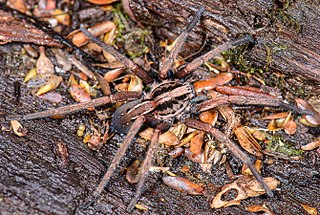
Miturgidae is a family of araneomorph spiders that includes nearly 170 species in 29 genera worldwide. First described by Eugène Simon in 1886, it has been substantially revised, including of previous family "Zoridae" as subfamily "Zorinae" and excluding the family "Xenoctenidae". Several genera have also been removed, such as the large genus Cheiracanthium, which was transferred to the Cheiracanthiidae.
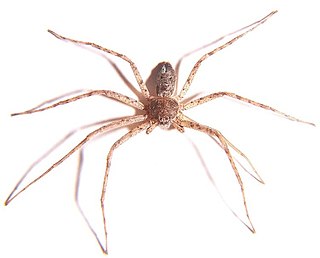
Philodromidae, also known as philodromid crab spiders and running crab spiders, is a family of araneomorph spiders first described by Tord Tamerlan Teodor Thorell in 1870. It contains over 600 species in thirty genera. Most are dull colored- brown, gray, yellowish or mottled with a leaf-like cardiac mark on the anterior dorsal abdomen, and seldom reach above 10 millimetres (0.39 in) long. None of the species build webs, but they do use silk for draglines and egg sacs.

Orb-weaver spiders are members of the spider family Araneidae. They are the most common group of builders of spiral wheel-shaped webs often found in gardens, fields and forest. "Orb" can in English mean "circular", hence the English name of the group. Araneids have eight similar eyes, hairy or spiny legs, and no stridulating organs.
William Henry "Harry" Butler was an Australian naturalist and environmental consultant, best known as the presenter of the popular ABC television series In the Wild from 1976 to 1981.
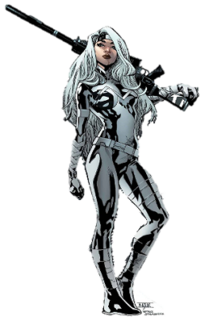
Silver Sable is a fictional character appearing in American comic books published by Marvel Comics. She is usually depicted as a mercenary, hunter of war criminals, leader of the Wild Pack, and owner of Silver Sable International. While not a criminal, her work as a mercenary has sometimes brought her into conflict with several superheroes. Silver Sable is primarily an ally and sometimes enemy of Spider-Man.

Wandering spiders (Ctenidae) are a family of spiders that includes the Brazilian wandering spiders. These spiders have a distinctive longitudinal groove on the top-rear of their oval carapace similar to those of the Amaurobiidae. They are highly defensive and venomous nocturnal hunters. Despite their notoriety for being dangerous, only a few members of Phoneutria have venom known to be hazardous to humans, but the venoms of this family are poorly known, so all larger ctenids should be treated with caution.

Tord Tamerlan Teodor Thorell was a Swedish arachnologist.

Dwarf sheet spiders (Hahniidae) is a family of araneomorph spiders, first described by Philipp Bertkau in 1878. Their bodies are about 2 millimetres (0.079 in) long, and they build extremely delicate webs in the form of a sheet. Unlike many spiders the web does not lead to a retreat. The silk used in these webs is so fine that they are difficult to spot unless they are coated with dew. They greatly favor locations near water or near moss, and are often found in leaf litter and detritus or on the leaves of shrubs and trees.

Gasteracantha is a genus of orb-weaver spiders first named by Carl Jakob Sundevall in 1833. The females of most species are brightly colored with six prominent spines on their broad, hardened, shell-like abdomens. The name Gasteracantha is derived from the Greek gaster (γαστήρ), meaning "belly, abdomen", and akantha (άκανθα), meaning "thorn, spine". Spiny-backed orb-weavers are sometimes colloquially called "crab spiders" because of their shape, but they are not closely related to the true crab spiders. Other colloquial names for certain species include thorn spider, star spider, kite spider, or jewel spider.

Arthur Gardiner Butler F.L.S., F.Z.S. (1844–1925) was an English entomologist, arachnologist and ornithologist. He worked at the British Museum on the taxonomy of birds, insects, and spiders.

Barychelidae, also known as brushed trapdoor spiders, is a spider family with about 300 species in 42 genera. Most spiders in this family build trapdoor burrows. For example, the 20 millimetres (0.79 in) long Sipalolasma builds its burrow in rotted wood, with a hinged trapdoor at each end. The 10 millimetres (0.39 in) long Idioctis builds its burrow approximately 5 centimetres (2.0 in) deep, just below the high tide level, sealing the opening with a thin trapdoor.
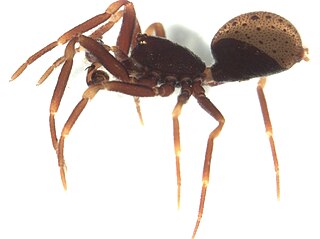
Malkaridae is a small family of araneomorph spiders first described by Valerie Todd Davies in 1980. In 2017, the family Pararchaeidae was brought into synonymy with Malkaridae.
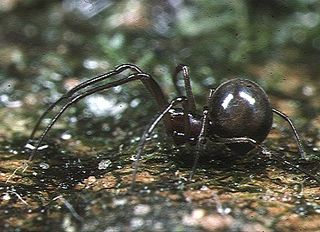
Anapidae is a family of rather small spiders with 231 described species in 58 genera. It includes the former family Micropholcommatidae as the subfamily Micropholcommatinae, and the former family Holarchaeidae. Most species are less than 2 millimetres (0.079 in) long.

Badumna is a genus of intertidal spiders that was first described by Tamerlan Thorell in 1890. They are harmless spiders that can be found around human structures and buildings. They are darkly colored, usually with a lighter colored pattern on the abdomen. The most well-known species is B. insignis, also known as the "black house spider" or "black window spider".
Perissopmeros is a genus of spiders in the family Malkaridae. It was first described in 1932 by Butler. As of 2017, it contains 7 species, all from Australia.
Corasoides is a genus of South Pacific intertidal spiders that was first described by Arthur Gardiner Butler in 1929. Originally placed with the Agelenidae, it was moved to the Stiphidiidae in 1973, and to the Desidae after a 2017 genetic study.

Barbara Anne York Main was an Australian arachnologist and adjunct professor at the University of Western Australia. The author of four books and over 90 research papers, Main is recognised for her prolific work in establishing taxonomy for arachnids, personally describing 34 species and seven new genera. The BBC and ABC produced a film about her work, Lady of the Spiders, in 1981.















